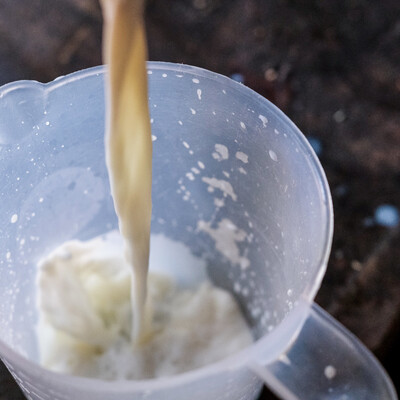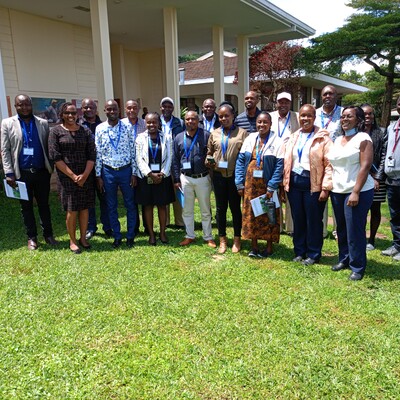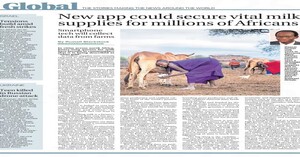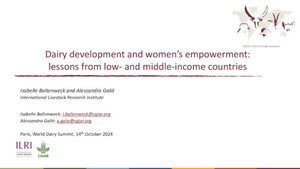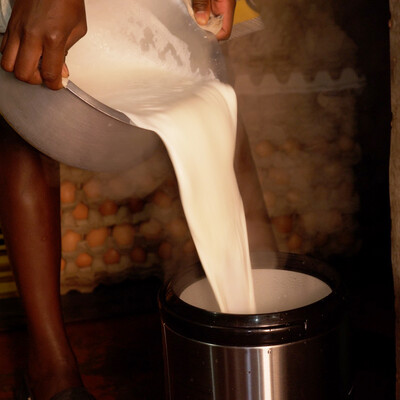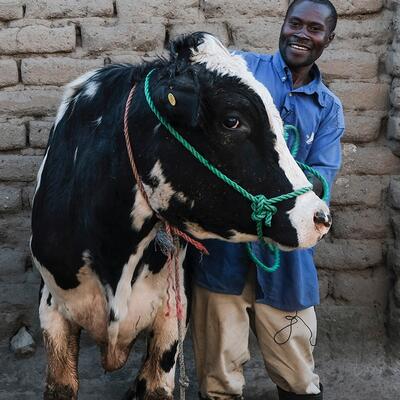

Dairy farmer extension services model: a successful research trial in Kenya's dairy sector
The livestock sector in Kenya is vital to many households. It provides food and income and is a major contributor to the country's economy. According to the Kenya Dairy Board, the dairy value chain contributes 4.5 %, 14%, and 44% to the national, agriculture, and livestock sub-sectors GDP, respectively. Currently, the total milk production is estimated to be 4.6 billion litres per year, against an annual demand of 8 billion litres.
The International Livestock Research Institute (ILRI) is working with other dairy stakeholders in Kenya to address the major factors contributing to this supply gap. The challenges identified include low productivity and poor-quality dairy products caused by high production costs, production inefficiencies, use of inappropriate technologies, ineffective extension services, and institutional weakness of dairy cooperatives.
Through the CGIAR research initiative on Sustainable Animal Productivity for Livelihood, Nutrition and Gender (SAPLING), ILRI, in collaboration with Alliance Bioversity and CIAT, developed an innovative approach for delivering advisory and enterprise management services to smallholder dairy farmers—the dairy farmer assistant (DFA) extension services model. This model deploys privately contracted extension services personnel to provide targeted advice and has shown great potential to improve farm management and productivity in the ongoing study. Extension services refer to the provision of information, technologies, and training on the best dairy practices and any other viable support to the farmers.
Seven dairy cooperatives in Uasin Gishu, Kakamega, and Nyandarua counties were selected to participate in the experimental study evaluating the impact of the DFA extension services model. The SAPLING initiative worked with the cooperatives to identify young graduates from tertiary colleges who were then trained by ILRI and deployed to work as DFAs. The seven cooperatives include Anaibkoi, Tuiyotich, Tuiyo, and Muungano (in Uasin Gishu), LULI Union (in Kakamega), and Nyala and Muki (in Nyandarua).
The DFAs were deployed to extension zones identified by the cooperative, with each DFA allocated 50 randomly selected farmers for extension services support. Over the past year, the DFAs made weekly visits and trained the farmers on various aspects, including pasture establishment, improved breeding, calf rearing, milking techniques, hygiene, animal health, record keeping, feed formulation, and fodder conservation, among others.
The training was targeted at the farmers' needs, which were identified during the first visits. The DFA extension model has been highly appreciated by the farmers, cooperative officials, and the extension personnel themselves. Eucabeth Cheptoo served as the DFA for Anaibkoi Cooperative, and she says that the individual farm visit model of extension works better than training farmers in a group because she could easily win the trust of visited farms and therefore easily influence farmers’ behaviour. She was also able to monitor progress and offer remedial measures when things were going wrong.
Her sentiments are echoed by David Simiyu, who served as a DFA at LULI Cooperative Union. Simiyu notes that each visit presented an opportunity to improve the farmer's welfare. He has designed and seen the construction of several cow sheds, and more farmers have been asking for them.
Mumbi Waihenya, a DFA at Muki Cooperative, explains how the farmers appreciated the training received during the project since they now know their role in selecting the right breed of cows for their farms, the right fodder to plant and ways to conserve the forages, among other benefits.
Eucabeth Cheptoo, DFA, Ainabkoi Cooperative, Kenya
Oliver Simwa, farmer, Luli Cooperative, Kenya
Mumbi Waihenya, DFA, Muki Dairy Cooperative, Kenya
The Cooperative officials also reported improved milk production from the farmers involved in the DFA model. Joseph Karanja, the head of extension services at Muki Cooperative, noted that some farmers had recorded an increment of up to three litres of milk per cow, translating into higher income for the supported households.
At Tuiyo Cooperative, Paul Siret, who chairs the cooperative, noted that milk collection had gone up from 1500 to 3200 litres per day since the inception of the project.
Nelly Masika, treasurer of Springfield Cooperative in Kakamega County, also reported growth in milk collection which led to them acquiring an additional milk cooler.
In Anaibkoi Cooperative, Faith Chelagat, who heads the extension unit, adds that farmers also reported lower calf mortality rates and had well-maintained farm records.
Joseph Karanja, extension manager, Muki Cooperative
Paul Siret, chairman, Tuiyo Cooperative, Kenya
Nelly Masika, treasurer, Springfield Cooperative, Kenya
Faith Chelagat, extension manager, Ainabkoi Cooperative
In a unique success story of the DFA model, Oliver Simwa, a member of the LULI Cooperative Union, reports his successful entry into dairy farming through the DFA model. One year ago, the DFA began the journey with him by establishing pastures and subsequently building a cow shed. Now, he has three cows, one in-calf and two lactating ones, each producing 20 litres of milk per day.
Emily Nanjala, the DFA who has walked with Simwa through this successful journey, says the model has provided her a platform to practice her career and enabled her to make a lasting impact in the lives of her community members.
Oliver Simwa, farmer, Luli Cooperative, Kenya
Emily Nanjala, DFA, Luli Cooperative, Kenya
Daniel Kiptoor, a farmer at Ainabkoi, explains how happy he is now that he has planted a type of forage called super Napier grass, acquired a chaff cutter to aid him in chopping the fodder, and built a cow shed, among many other benefits from the DFA extension model.
In similar sentiments, David Koech, a farmer from Tuiyo cooperative, says that his animals now have better health, drink clean water, and have reduced distance covered during grazing to help increase the milk yield.
In Muki Cooperative, Wilson Munyoi expresses his gratitude for being part of the program. He says that he previously had to sell his high-yielding dairy cows due to a looming drought, but not anymore now that he has planted super Napier grass and is well informed on how to conserve it for future use.
Daniel Kiptoor, farmer, Ainabkoi Cooperative, Kenya
David Koech, farmer, Tuiyo Cooperative, Kenya
Wilson Munyoi, farmer, Muki Cooperative, Kenya
Jane Tanui, the livestock production officer in Kapsaret, noted that the model has been helpful in easing her load of extension. However, she notes that even with the additional support, many farmers have not been reached, and more DFAs are needed to fully assist farmers in the area.
Stella Chepkemei, one of the DFAs she worked with, noted that though it was challenging having to cover large distances, the results of farmers' increased milk production and improved cow handling are satisfactory.
Jane Tanui, livestock officer, Kapsaret, Kenya
Stella Chepkemei, DFA, Tuiyo Cooperative, Kenya
ILRI’s James Rao, a senior scientist who leads the SAPLING Initiative in Kenya, observed that the approach has progressed well and seen farmers adopt improved animal husbandry practices, which will likely translate into improved productivity and profitability. However, given that it was run as a co-payment model between the initiative and farmers, some farmers pulled out at the point they decided that they did not want to co-pay for the DFA extension services anymore. The SAPLING team is conducting a final evaluation and exploring a more sustainable institutional anchorage for the DFA extension model. The ongoing assessment intends to show the businesses that benefit most from the targeted model of extension and bring them on board as potential supporters of the DFA model.
The current study has been done in collaboration with PERFOMETER Agribusiness, a dairy consulting firm that supports smallholder farmers.
James Rao, ILRI and SAPLING Kenya lead
Silas Maosa, manager, Perfometer agribusiness
Access more outputs from SAPLING Kenya here.
You may also like

HABITAT- Farmer workshops on biodiversity and pasture biodiversity assessment on highland dairy farms

ILRI News
The Africa Asia Dairy Genetic Gains project launches mobile app to track dairy animal performance

ILRI News
Cultivated forages boost production and income for dairy farmers in Bishoftu District, Ethiopia
Related Publications

Milk somatic cell count, composition and yield of multi-breed dairy cattle in Ethiopia
- Chernet, T.F.
- Okeyo Mwai, Ally
- Meseret, Selam
- Negussie, E.
- Mrode, Raphael A.
- Tarekegn, G.M.
- Edea, Z.
- Gebreyohanes, Gebregziabher
- Ekine-Dzivenu, Chinyere
- Tera, A.
- Tessema, T.S.

Moving milk and shifting risk: A mixed methods assessment of food safety risks along informal dairy value chains in Kisumu, Kenya
- Smith, L.C.
- Stringer, A.
- Owuor, K.O.
- Ndenga, B.A.
- Winter, C.
- Gerken, Keli N.
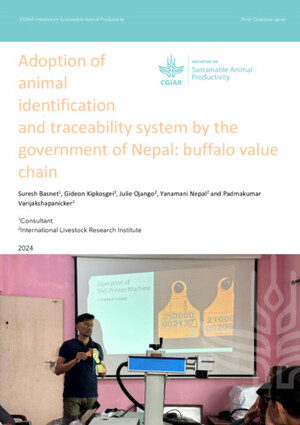
Adoption of animal identification and traceability system by the government of Nepal: Buffalo value chain
- Basnet, Suresh
- Kipkosgei, Gideon
- Ojango, Julie M.K.
- Yanamani, Nepal
- Varijakshapanicker, Padmakumar





